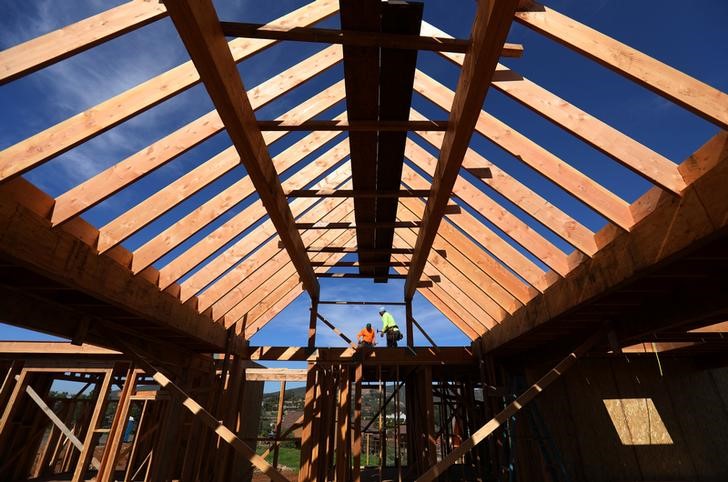By Lucia Mutikani
WASHINGTON (Reuters) - U.S. homebuilding rose more than expected in March amid a rebound in the construction of multi-family housing units, but weakness in the single-family segment suggested an acute shortage of homes for sale will likely persist.
Other data on Tuesday showed a solid increase in industrial production last month as cold weather boosted utilities output and production at mines surged. The reports underscored the economy's underlying strength even though growth in the first quarter is expected to have slowed after three straight quarters of brisk expansion.
"This continues the theme that the output and labor data paint a stronger picture of the economy than we expect first-quarter real GDP to do in part because of a seasonal bias we believe exists in the GDP data," said John Ryding, chief economist at RDQ Economics in New York.
Housing starts rose 1.9 percent to a seasonally adjusted annual rate of 1.319 million units, the Commerce Department said. Data for February was revised up to show groundbreaking declining to a 1.295 million-unit pace instead of the previously reported 1.236 million units.
Economists polled by Reuters had forecast housing starts rising to a pace of 1.262 million units last month. Permits for future home building rose 2.5 percent to a rate of 1.354 million units in March.
U.S. financial markets were little moved by the data. Stocks on Wall Street were trading higher as strong earnings from Netflix (O:NFLX), Goldman Sachs (N:GS) and healthcare companies bolstered optimism over what is expected to be the strongest earnings season in seven years.
The dollar rose against a basket of currencies, while U.S. Treasury prices fell slightly.
Single-family homebuilding, which accounts for the largest share of the housing market, fell 3.7 percent to a rate of 867,000 units in March. Permits for single-family home construction dropped 5.5 percent to an 840,000 unit-pace, the lowest level since September 2017.
A survey on Monday showed confidence among homebuilders fell in April for a fourth straight month. Builders complained about a lack of buildable lots and increasing construction material costs. According to the survey, tariffs imposed by the Trump administration on Canadian lumber and other imported products were "pushing up prices and hurting housing affordability."
TIGHT SUPPLY
Homebuilding will probably not increase significantly to eradicate an acute shortage of houses on the market, which is pushing up prices and sidelining some first-time home buyers.
Demand for housing is being driven by a robust labor market, which is underpinning the economy. Single-family home construction fell in the Northeast, South and West, but rose in the Midwest.
Starts for the volatile multi-family housing segment surged 14.4 percent to a rate of 452,000 units in March. Permits for the construction of multi-family homes jumped 19 percent to a 514,000 unit-pace.
The outlook for housing inventory was mixed. Housing completions fell 5.1 percent to 1.217 million units last month, with single-family units dropping 4.7 percent. But the stock of housing under construction rose 0.3 percent to 1.125 million, the highest level since July 2007.
Single-family units under construction climbed 0.2 percent to the highest level since June 2008.
"Construction remains below levels needed to return the market to a normal supply/demand equilibrium, so we can expect affordability and availability problems to continue into the foreseeable future," said Robert Frick, corporate economist at Navy Federal Credit Union in Vienna, Virginia.
In a separate report on Tuesday, the Federal Reserve said industrial production rose 0.5 percent in March after jumping 1.0 percent in February.
It was boosted by a 3.0 percent surge in utilities production and a 1.0 percent increase in output at mines. Manufacturing production, however, rose only 0.1 percent after soaring 1.5 percent in February.
"The fact that the manufacturing sector was able to notch a gain on top of February's substantial increase suggests that, overall, the manufacturing sector remains in good shape," said Tim Quinlan, a senior economist at Wells Fargo (NYSE:WFC) Securities in Charlotte, North Carolina.

Economists, however, worry that a brewing trade war between the United States and China could cause disruptions to the supply chain and undermine manufacturing.